Is Printing From Photoshop the Best for Fine Art Prints
This chapter is from the book
Printing from Photoshop
The Photoshop Print Settings dialog box is a relatively circuitous and powerful print control eye. On the left is a preview of your image. On the correct are all the settings that y'all accept to master. You take to brand absolutely sure you've got each one correctly set; miss one and you've ruined your expensive fine art print.
When I was immature, I had an art instructor who said you are embellishing the art of a previous artist whenever y'all put pencil to paper. What he meant was that someone has put a great deal of time and craftsmanship into creating this great piece of newspaper, so don't screw it upwards. Thinking most it that way gives you a good for you degree of respect for the medium and the substrate.
So, how not to spiral up? I'll walk y'all through the dialog box and then yous know how to get the results you want.
Starting at the top, in the Printer Setup area, it's cocky-apparent to select the correct printer. So click the Print Settings button.
The Photoshop Print Settings dialog box
Photoshop engineers accept washed a pretty skilful chore of making the impress dialog boxes the same beyond platforms. In essence, the options are identical on Mac and Windows. Information technology'due south just the print properties versus impress settings that are different. Figure 4.8 shows the main Photoshop Print Settings dialog. If mine looks a bit different, I suspect it'southward because of some of the options I've chosen (which I'll highlight later). The dialog box is broken upwards by the panel areas for the various settings you must select.
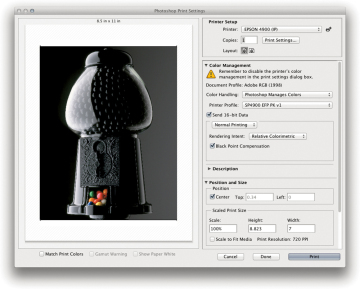
Figure 4.eight. The Photoshop Print Settings dialog box.
Printer Setup panel
The first step is to select the printer and set the print settings for your specific printer. The other matter to accost in the Printer Setup area of the dialog box is Layout. Yous must set to print in portrait or landscape mode. Sadly, Photoshop's Print dialog box nonetheless tin't automobile-rotate your epitome. Figure iv.9 shows the Printer dropdown menu (notice my nice tidy printer names) and the Impress dialog box you go when you click the Print Settings button.
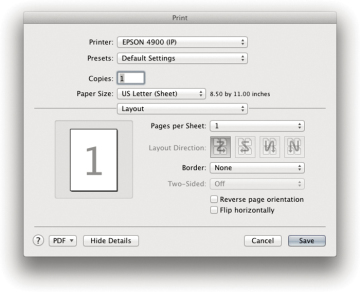
FIGURE iv.9. The Printer dropdown card and the Print dialog box.
THE PRINT DIALOG BOX
Color Management console
In the Color Management expanse of the dialog box, cull a Color Handling option. You've got two, basically: Printer Manages Colors and Photoshop Manages Colors. Unless y'all're printing black-and-white images using a special module, which I'll describe later in this chapter, you want Photoshop to manage colors. Effigy 4.ten shows the Colour Handling menu and the Printer Contour menu of ICC profiles.

Figure 4.10. The Color Handling dropdown menu and the really long Printer Contour menu.
THE Actually LONG PRINTER PROFILE MENU
After you cull Photoshop Manages Colors, select the advisable profile. Unfortunately, Photoshop shows you all of your installed profiles—and that list can be overwhelming. Be sure you select the right printer profile. I'm climbing onto my soapbox for a moment here to say that each color profile should be named usefully, not as a marketing tool. It would be useful if Epson and Canon, for example, understood that creating a profile named Epson Stylus Pro 7900-9900 and then the bodily media proper noun is a majestic hurting in the donkey for the user. I'd like to see a naming convention that groups profiles for a single printer together, but also makes information technology like shooting fish in a barrel to place the media you're selecting.
Y'all accept the option to transport 16-fleck data. I'll do that.
Side by side, choose either Normal Printing or Difficult Proofing. Choose Hard Proofing when you're doing cross-rendered proofing, particularly if you lot're proofing for halftone reproduction. When you select Hard Proofing, select your saved Proof Setup—or, in this instance, I can select Working CMYK. So select Simulate Paper Color. With that choice selected, Photoshop will direct the printer to print a scum dot on the paper to simulate the paper white bespeak that'south in the paper profile. Figure 4.xi shows the dropdown carte du jour and the result of selecting Hard Proofing.

Figure 4.xi. The printing blazon menu and the result of selecting Hard Proofing.
THE Hard PROOFING Selection
In nigh cases, you lot'll cull Normal Press. The side by side parameter to select is Rendering Intent. In this case, I'll choose Relative Colorimetric or Perceptual. I'll cull Relative Colorimetric rendering because that was the best intent when soft proofing. Absolute Colorimetric and Saturation aren't skillful choices for fine fine art printing. The reason I selected Relative Colorimetric was, of form, because that was the best rendering intent when I was soft proofing the image. Ever select Black Point Bounty because information technology maps the prototype'south black indicate to paper black, going higher up and beyond the ICC specification. Information technology'southward a good thing. Effigy four.12 shows the Rendering Intent dropdown menu.
Description panel
The Description console is basically a tool tip. As you hover your cursor over different areas of the dialog box, it provides a description of the options. I won't bother with a figure; try information technology yourself adjacent fourth dimension y'all impress.
Position and Size panel
In the Position and Size surface area of the Photoshop Print Settings dialog box, you can choose to center the prototype. Recall that information technology will be centered inside the printable margins. If you have asymmetrical margins, information technology volition be centered not according to the newspaper dimensions but relative to the printable margins. You control those printable margins when yous prepare your custom paper size. Figure 4.13 shows the Position and Size panel.
As I said in Affiliate 3, you lot desire to resize and resample mode earlier yous get here—so don't click Scale to Fit Media, or change the height and width. Yous've already done that. I'll also warn you lot that trying to move the image inside the printable surface area past grabbing and moving tin can exist problematic, and using the Top and Left text entry boxes is a pain. In that location needs to exist a redesign of this part that makes it easy to accurately position the epitome on the page (sort of similar Lightroom).
If y'all wanted to print a quick proof of a selected expanse, you could select Print Selected Area. When you select information technology, you lot get little cropping marks in the preview, and so you lot can print a swath. Effigy 4.14 shows the choice to print merely a selected area if you check the Print Selected Expanse button.
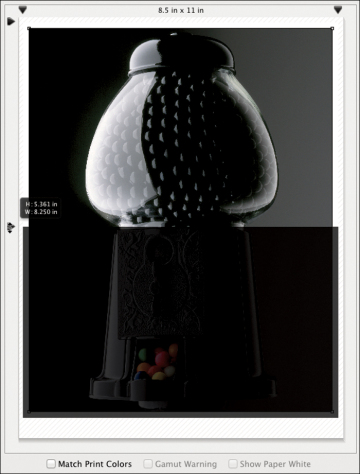
FIGURE four.14. Adjusting the expanse to impress subsequently selecting Print Selected Surface area pick.
Press Marks, Functions, and PostScript Options panels
The options in both the Printing Marks and Functions areas of the dialog box are typically useful only in the graphic arts and non something you would unremarkably use when fine art press.
If y'all're using a PostScript printer, there would PostScript options. But near inkjet printers are not PostScript. With a non-PostScript printer selected, those options aren't bachelor. Figure 4.15 shows the iii panels. To be honest, I never use these options, but they could come up in handy someday (although I doubt it).
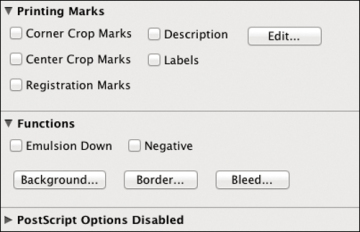
Figure four.xv. The Press Marks, Functions, and PostScript Options panels.
Friction match Impress Colors
In that location are three options under the image preview: Match Print Colors, Gamut Alarm, and Show Paper White. These options essentially allow you lot to soft proof correct in the Photoshop Print Settings dialog box. It's interesting, but not all that useful, considering you're non in a position to do annihilation about it. All the soft proofing should take been done before y'all choose Print, so I leave those all unchecked. Figure 4.16 shows before and afterward selecting the Match Impress Colors option. There is one situation where using this option tin can come up in handy, and that is if you lot have curt-term memory loss and y'all can't remember which rendering intent looked the best for your image. In that instance, select the Match Print Colors option and try toggling back and forth through the rendering intents.
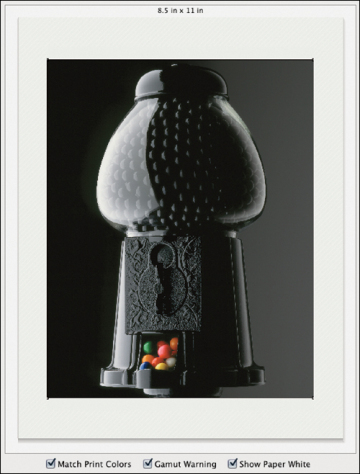
Effigy four.16. With and without the Friction match Print Colors options.
After
Customizing the Photoshop Print Settings dialog box
In the beginning of this affiliate I mentioned that my Photoshop print dialog box might look unlike than yours. Here'southward why: I used the context menu (Command-click on the Mac or right-click in Windows) to change the background display. Past default, information technology has a rather "distracting" diagonal line blueprint that I really detest. Figure 4.17 shows the default brandish and the context menu to modify it. I selected a unproblematic white custom color. I retrieve it makes it expect more like a "impress"!
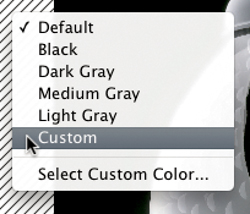
FIGURE four.17. The default dialog advent with a distracting diagonal blueprint and the context menu.
THE CONTEXT MENU Allowing Yous TO Modify It (WHICH I HOPE Y'all DO)
Done or Salve buttons
At this phase, you lot're prepare to impress or salvage the impress settings for apply after. You should realize that clicking Washed or Impress will really "dirty" your file. By dirty I hateful it adds the print settings y'all've selected into the file, which volition require saving it. You tin can cull to shut the file without saving, just I find it useful to store the concluding print settings in the epitome. Past the style, hit Cancel will cancel the settings and your file won't be dirtied.
Printer-specific settings
When you click the Impress Settings push button, you lot get out the Photoshop dialog box and communicate directly with the printer commuter. You'll be selecting options that are specific to your printer model.
To my mind, at that place are really merely two fine art printer manufacturers left: Canon and Epson. HP was doing nifty for a while, but it doesn't seem to be updating its printers nor (I've heard) manufacturing parts for its fine art printers anymore. So, I'll walk through the options for the Epson Stylus Pro 4900 and the Canon iPF6400 printers I have at my disposal. Both are pro-level printers. Consumer-level printers won't have the exact same sort of options in the printer driver, so yous'll have to extrapolate the settings you need for your own printer. I'll talk about the settings on the Mac offset and address the differences in Windows a little later on.
Epson Stylus Pro 4900 settings
Yous accept the ability to brand printer presets. Generally, I consider that useful if yous're printing from Photoshop, merely it'due south contraindicated if yous're printing from Lightroom. Once we go through this, if you want to create a custom user preset, I'll get out that up to you.
Press on a Mac. When you click on the Print Settings button, you get a special Os-supplied combination of the former Page Setup and the printer-specific driver functions. Effigy 4.18 shows the initial Print dialog box with the chief dropdown menu expanded. The items at the acme of the listing are from the old Page Setup dialog box, and the ones below the line are from the printer commuter itself. The lesser option, Supply Levels, connects to the printer and displays the current ink levels per color.
The showtime pace earlier choosing the printer settings is to select the Paper Size. In this instance, I'll select US Letter of the alphabet (Sail). You can also select U.s.a. Letter, Curlicue Paper – Banner, but I'm but going to print on a sheet. The newspaper you select here will modify the printer driver settings later in the Printer Settings dialog box. The Paper Sizes displayed are specific to the printer selected at the top Printer dropdown menu. Figure iv.nineteen shows the choice of the newspaper size.
I by and large create custom sizes. If you gyre all the way to the bottom of the Paper Size carte du jour for the Epson Stylus Pro 4900, for example, you'll see the Manage Custom Sizes pick. In the Custom Paper Sizes dialog box, you can control the summit, width, and printable margins. I'll enter 8.5 × 11 inches. Depending on the printer model, y'all may be able to center the image. Some printers have asymmetrical top and bottom margins. The Epson Stylus Pro 4900 that I'm working with here has a default of 0.56 inches on the bottom and 0.13 inches on the top and sides. Then to eye my prototype, I'll alter those margins to 0.75 inches all the way effectually, and so click OK. Figure 4.xx shows the Custom Paper Sizes dialog box.
Generally, when I print, I want a minimum margin of newspaper around the printed epitome for purposes of handling and long-term conservation. You don't want to print all the way to the edge where people will use sticky fingers to hold information technology. Depending on whether you do an overmat, the margin may not even show. It's a style of existence more conservation-minded.
Afterward you click OK, information technology's important to make sure the newspaper size is actually what you selected. Sometimes changes you make in these dialog boxes have unintended consequences. This is a prime number opportunity for mistake. It's been my feel that yous need to send the correct paper size to the printer or you won't get the expected results (this is an ironic comment).
Color matching is something you don't demand to command. If y'all've prepare the colour handling in the colour management department of Photoshop to Printer Manages Color, those options aren't changeable.
Side by side, set the printer specifications, such as whether the printout is based on sheet or roll paper. It would exist nice if the printer commuter would communicate with this dialog box, because it seems like information technology should option up the options I already set, but it doesn't. Be careful hither. This is some other potential gotcha bespeak—if you lot set it to print to a sheet in one identify merely not the other, it's a trouble. If you've got a newspaper cassette for the Epson 4900, you can choose transmission feed or cassette. Effigy 4.21 shows the options in the Page Setup dropdown menu. Depending on whether or non your page setup indicated canvass or roll, you'll have different options.
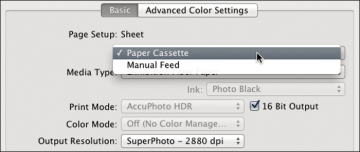
FIGURE 4.21. The Page Setup dropdown menu.
Page SETUP WHEN A CUSTOM PAGE SIZE IS SET WITHOUT SPECIFYING Canvas OR ROLL
Note that, especially for Epson printers, the paper feed path often dictates the pick of media. If you select Paper Cassette, for example, y'all can't select some of the fine fine art heavy watercolor papers; to use those, you need to select manual feed. Additionally, different printers, such as the R3000 or 3380, tin practice a front or back manual feed. Depending on your printer model, selecting a media blazon is potentially rather complicated. The Epson Stylus Pro 4900 is compatible with different photo papers, and information technology'south nice that they're organized hierarchically in the file menus. Previously, they were all in one carte du jour, which was even more than conducive to user error. I have menus for photograph paper, proofing newspaper, and fine art paper. Just in the art menu, papers such as velvet fine art or hot and common cold press watercolor papers are dimmed because they can't be printed from the paper cassette, which is what I've selected. Effigy 4.22 shows the media options express by the paper feed path.
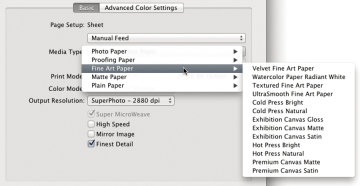
Effigy 4.22. Comparison media options based on the newspaper feed path.
ALL FINE ART PAPER MEDIA OPTIONS ARE AVAILABLE IN MANUAL FEED Page SETUP
If yous're using a tertiary-party paper, you should utilise a media type that is suggested by the manufacturer. You tin can use the ICC profile supplied by the paper manufacturer, but if you've fabricated a custom profile, you should choose the paper media type that you used when you actually profiled the paper.
Below the Media Type menu, the Ink menu is dimmed, and it'southward set up to Photo Black. Y'all tin can't modify it here; you'd have to do a photo black to matte black swap in the impress driver or the front console of the printer.
Considering I've chosen Photoshop Manages Colors in the Photoshop Printer Settings dialog box, the Color Mode menu here is automatically dimmed. Color direction is off. Figure iv.23 shows the dimmed Print Mode and Color Manner with the 16-scrap option selected. Yous'll see the sixteen-bit option available only if yous are printing a sixteen-bit epitome.
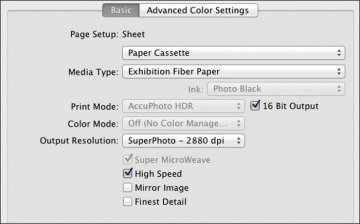
FIGURE 4.23. The dimmed Impress Mode and Colour Mode options.
The next carte du jour is Output Resolution. I talked about printer resolution in Chapter 3, and this is where you lot'll set it. I would prefer that card items were technically accurate and not marketing jargon—SuperPhoto doesn't hateful anything, but the resolution numbers do. Keep in listen that these numbers aren't dots per inch, only aerosol per inch. Here, I'll select Exhibition Fiber Paper and set the resolution to 2880. Effigy iv.24 shows selecting SuperPhoto 2880 DPI and the final settings, with High Speed selected.
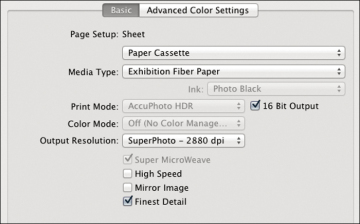
FIGURE four.24. Selecting the Output Resolution and the boosted Loftier Speed and Finest Detail settings.
HIGH SPEED DESELECTED AND FINEST DETAIL SELECTED
The High Speed option lets the printer heads spread ink bidirectionally, so images print literally twice equally fast as they exercise when that option is off. Depending on your newspaper type and resolution, this is a good selection and saves a lot of time. As I'll explain in a moment, y'all should deselect High Speed if you select Finest Item.
The Finest Detail option is unique to Epson (although Canon pro printers besides accept a high-resolution reporting choice every bit well). Normally, the Epson printer's reported resolution is 360 dots per inch, and the Epson Pro printers actually have 360 nozzles per inch on the printhead. When y'all select Finest Detail, the driver reports to the impress pipeline that the printer is a 720-dots-per-inch device. This is a critical thing to understand. If you were printing a textural fine-detailed paradigm and the native resolution, uninterpolated, is above 360 pixels per inch, you'd desire to upsample to 720 and select Finest Detail. In Chapter 5, you'll see proof that printing at 720 is superior to press at 360, but for now, take my word for information technology. If you have enough resolution natively, it's worth printing Finest Particular and upsampling to 720 PPI—and if you select Finest Particular, consider deselecting Loftier Speed.
The advantage in selecting Finest Detail applies primarily to sleeky media. The resolvable item will vary considerably with matte media. Some matte media, such every bit Ultrasmooth Fine Fine art and enhanced matte (or ultrapremium presentation matte), can apply a college resolution, such as 1440 or 2880. If you're press to sheet, y'all can set the resolution to 1440 or even down to 720. It all depends on the surface or substrate you're printing to.
You also accept a xvi-Bit Output option on the Mac. If you've been working in 16 bits, in that location's no reason to driblet down to 8 bits per channel merely to make a print. Withal, it'southward mostly going to brand a potent difference only if you're printing images with various complex gradients from Illustrator. It doesn't utilize that much when you're printing pixel images from Photoshop. But if you're printing from a Mac, the option is at that place, so get alee and utilize it. Be aware that there have been cases reported where certain printers have a issues with 16-bit output, and so double-check that press with it on or off gives y'all the results y'all expect.
So far we've been in the Basic panel. There are other dialog boxes available that may need to be gear up depending on the media you are press on. Figure 4.25 shows the Roll Paper Settings (if you are printing on rolls) and the Avant-garde Media Control console with the Platen Gap dropdown menu. Changing these options is needed only if you lot are setting up and printing out to non-Epson media. Setting the Media Blazon will gear up all of these options automatically for Epson media.
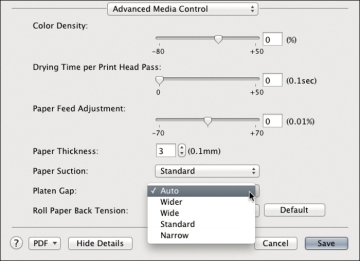
Figure iv.25. The Ringlet Paper and Advanced Media Command options.
Avant-garde MEDIA Control
Printing in Windows. If you lot're working in Windows, you'll see the printer driver settings are very similar but in a different configuration. Effigy 4.26 shows the Epson Stylus Pro 4900 Properties dialog box with the Main tab selected. The dialog box in this effigy has already been configured for all the standard settings and is gear up to click OK.
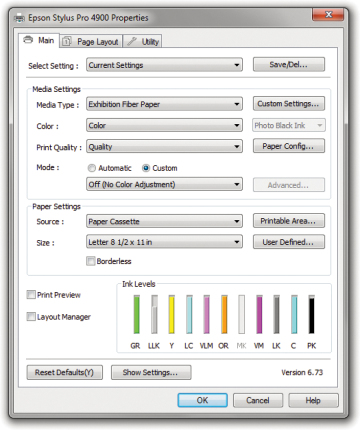
Effigy 4.26. The Epson Stylus Pro 4900 Properties dialog box in Windows.
Select Settings and Media Settings. Starting with the Select Settings bill of fare, select the printing quality (you'll want Highest Quality unless you are printing a draft). In the Media Settings area, select the Media Type (set to Exhibition Fiber Newspaper). In Media Settings, you have the aforementioned choices with the same limitations depending on the paper feed path, as previously mentioned in Figure four.22. Figure 4.27 shows each of the Main panel settings for Select Settings and Media Settings.

FIGURE iv.27. Selecting the quality and Media settings.
SETTING THE MODE—CLICK CUSTOM AND SELECT OFF (NO COLOR Aligning) FROM THE MENU
For color, you can select Color, Advanced B&W Photo. Black is dimmed because the prototype is in color. Print Quality doesn't give you the aforementioned geeky settings you accept on the Mac: y'all take matte quality or quality options. If you select quality options, you tin motion the slider over to about five. Just as with the Mac, you can select High Speed or Finest Detail—but you have to dive into the Quality Options area to observe the Finest Detail choice.
Under Mode, click Custom, and then turn color management off in the expanded options. On the Mac, ColorSync prevents you from doubling up on color management or accidentally turning it all off, only you tin can screw up more easily in Windows. It's a huge potential gotcha. I propose turning information technology off here, and be certain to choose Photoshop Manages Colors in the Photoshop Print Settings dialog box.
Newspaper Settings. Figure iv.28 shows the Paper Settings section, where you have the Source: Roll Paper, Paper Cassette, or Manual Feed. Depending on the media type you're using, you'll take to select the correct source. I'll select Newspaper Cassette. That enables a push button that allows you to control the printable expanse, and this is a fiddling different on Windows than it is on the Mac. Standard gives you lot standard printer margins; Maximum allows you lot to extend the printer margins but may produce poor quality near the bottom edge. Again, you tin can centre the image inside the printable margins.
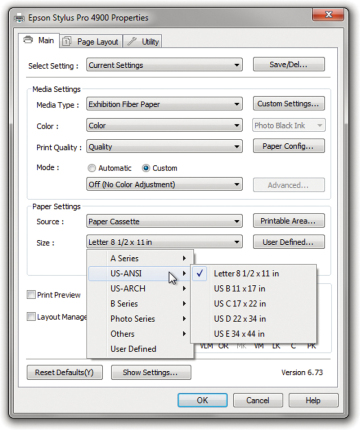
Figure 4.28. Setting the Paper Settings options.
THE USER-DEFINED PAPER SIZE DIALOG BOX (ACCESSED By CLICKING THE USER Divers... Push button)
Down below in the Page Settings y'all select the paper size. Unfortunately, in Windows, you choose from the A series, B series, Photo series, and others in a more complicated hierarchical brandish of paper sizes. However, you tin also select User-Defined and then create a custom printer size.
Page Layout. Under Page Layout, y'all can set the orientation and, again, it'due south important that the printer driver and the printer have the same orientation settings. This is another potential gotcha. Yous can also enlarge or reduce, but you should already have done that. Figure 4.29 shows the Page Layout tab. Note that in the Select Setting bill of fare, I've selected a saved setting named 4900 EFP. You can relieve user-defined settings by clicking the Save/Delete button. Information technology'southward useful because it allows saving oftentimes used settings to help cutting downwardly on user error.
Utility. Under the Utility tab, you can do nozzle checks and cleaning. It allows yous to alter the groups or the display order of the bill of fare, which might be useful, but it's not necessarily something I would advise doing willy-nilly. Sometimes Windows allows yous to exercise things maybe you shouldn't be able to do, such as changing the menu order and changing what is or isn't displayed.
Y'all tin can click the printer-specific utility. In this instance, information technology'due south the Epson LFP remote console. (LFP stands for large format printer.) The remote panel allows you to control and update the firmware, monitor and display the printer status, adjust the newspaper feed to fine-tune the bodily speed, and perform other tasks. I'll talk about this more in Chapter 5. Figure 4.xxx shows the main Utility tab and the EPSON LFP Remote Panel 2 dialog box (launched as a separate application by clicking the EPSON LFP push button in the Utility tab).
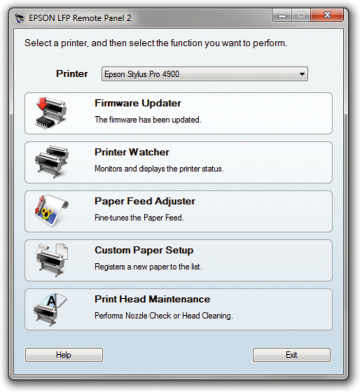
Effigy iv.xxx. The Utility tab and the EPSON LFP dialog box.
THE EPSON LFP REMOTE PANEL 2 DIALOG B0X
Click OK and you'll go back to the Photoshop Print Settings dialog box.
Canon iPF6400 settings
Just like the Epson 4900 commuter on the Mac, you first off with the main Print dialog box after clicking the Print Settings button in the Photoshop print dialog box. Effigy 4.31 shows the Main console of the Print dialog for the Catechism iPF6400 printer.
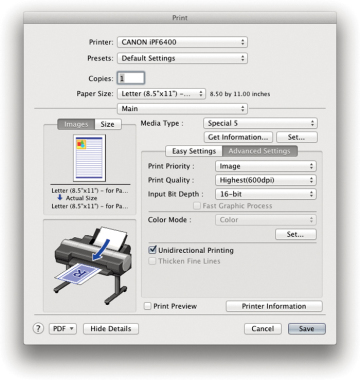
FIGURE 4.31. The Chief panel of the Canon iPF6400 Print dialog.
MAIN Panel SHOWING THE Avant-garde Console OPTIONS
Main panel. In Figure four.31, I've clicked on the Advanced Settings push to admission the more advanced setting options. When you select Photoshop Manages Color, the Easy Settings are dimmed. In the Primary dialog box, cull your media type. With Canon printers, yous demand to set the media blazon at the printer itself, and that setting has to match the media type you select in the commuter. This is a potential gotcha, so make sure you lot correctly set the media type on the printer and in the Principal printer dialog box. Figure four.32 shows the Media Blazon menu for Photo Newspaper and the "Special" menu. Since I'chiliad printing out to Hahnemühle FineArt Baryta paper, the manufacturer suggests using the Special 5 Media Blazon settings.
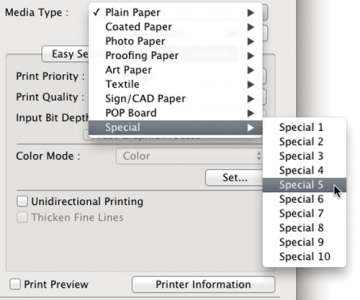
FIGURE four.32. Selecting the Media Type settings.
THE SPECIAL Bill of fare
Avant-garde settings. The Print Priority tin exist set to Prototype or Proof. I've never used the Proof setting. You lot can change the impress resolution and the impress quality. The quality is dictated by the media type. You can utilize Standard(600dpi) or Highest(600dpi), which reports 600 DPI to the operating organization and uses a higher number of passes to achieve maximum epitome detail. If you have a sixteen-bit image, y'all can select eight- or 16-fleck for the output. You tin can also choose unidirectional or bidirectional printing.
The colour mode options would be enabled but if y'all chose to have the printer manage color. Those options are dimmed considering Photoshop is managing the color. Figure 4.33 shows the diverse options in the Avant-garde tab.
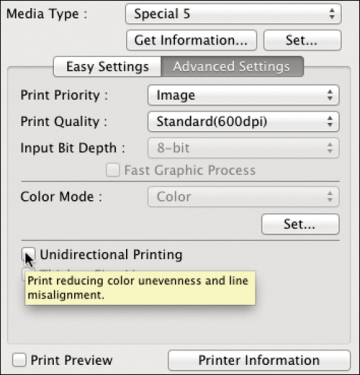
Effigy four.33. The Advanced tab options.
UNIDIRECTIONAL Option
Page Setup. Nether Page Setup, you accept the same essential ability to control the folio size and whether to resize to fit the page or to change the calibration. Again, you should have made whatever scaling changes to the epitome prior to printing. You accept the choice to impress the image centered within the printable margins. Figure four.34 shows the Page Setup panel and the Paper Source dropdown menu.
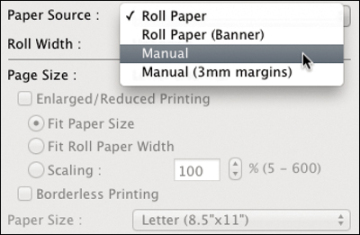
Figure iv.34. The Page Setup panel.
THE Newspaper SOURCE DROPDOWN MENU
Utility. With the Utility dropdown, you can perform printer maintenance, start the print monitor, or configure the colour prototype runner enlargement copy (don't inquire; I take no clue what that is). Figure 4.35 shows the Utility Console options.
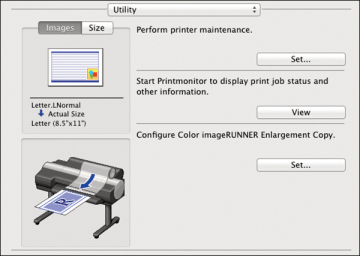
FIGURE 4.35. The Utility panel (with options I've never used).
Under additional settings, you can specify a data ship method, whether to spool or print straight without spooling. If you send direct, information technology ties up the CPU for your computer; don't know if it'southward modal or not, but I'd ship all print data every bit a batch to spool it to the printer and then the CPU sends but what the printer tin can grab at a specific time. Since the settings are grayed out, I won't bother to evidence a figure.
Printing to Windows. Yes, the Canon iPF6400 has a Windows driver. Figure iv.36 shows the Main panel of the Canon iPF6400 Properties dialog box. If you wait closely at the dialog head in Figure four.36, you'll run across a (2) after the printer'due south name. I inserted the number because I added the printer two ways, one time via USB and the other via Ethernet. I won't carp to drill downwardly on the private panels, but suffice information technology to say, all the same features for the Mac commuter are available for the Windows driver—only in different locations.

Effigy four.36. The Windows printer properties dialog box showing the Main console.
Press from a Photoshop printer plug-in
The only existent print export plug-in that I'm enlightened of is provided by Catechism. At 1 point, Epson had an excellent plug-in, but the company chose to concentrate on the printer commuter and dropped it. To its credit, Canon has developed and maintained its plug-in. To access the Catechism print plug-in, choose File > Export > iPF6400 Print Plug-in. Figure four.37 shows the imagePROGRAF Plug-In for Photoshop dialog.
1 reason to utilize the plug-in versus the printer driver is that Canon claims and my tests confirm that the gamut is a little bit bigger nether the plug-in than through the printer driver. I volition show a 3D gamut plot of the ICC profile I made through the actual application and impress pipeline and the ICC profile I made or the Art Baryta newspaper for the actual plug-in. It's subtle, just information technology's bigger. In terms of gamut, generally speaking, bigger is better. Effigy four.38 shows a graph taken from ColorThink showing the gamut differences betwixt the printer driver and the plug-in color gamut.
The plug-in provides a preview and has five main tabs. Under the Master tab, you can select the printer, and since I have merely one, it's easy to select. It allows you to set the media type. I've chosen Special 5 because I'm printing out to Hahnemühle FineArt Baryta paper.
The Input Resolution to Plug-In is set to Loftier Accurateness, which is 600 PPI. For the Input Fleck Depth to Plug-In, high gradation is 8 bit, and the next highest gradation is 16 chip. The plug-in allows you to command the impress mode, which is highest or highest maximum number of passes. Y'all want to print the highest number of passes. That means the printhead passes back and forth more than accurately. Under Output Profile, yous can select the ICC profile. I'll select the profile I made for the plug-in. You either need to brand custom profiles or use the general Catechism profiles; they don't offer any profiles specific to the plug-in. Then, for optimum output quality, you'd desire to make your own custom profile.
Under Matching Method, you can select Perceptual Colorimetric or Relative Colorimetric. You could also select Saturation, but it's not optimal. And you can command and modify the ICC conversion options. You tin can use the Bone standard (on Mac, that's Apple tree CCM) or you can cull the Adobe CCM. Currently, the Adobe CCM has not been released as a stand-alone CCM, and so fifty-fifty though I was able to choose information technology, I got a warning that I'chiliad locked into the Os standard. On the Mac, that'due south Apple tree CCM; for Windows, information technology would be the ICM CMM.
Y'all can also set the configuration. You can actually apply sharpening, but yous should never do output sharpening here—do it in Photoshop or Lightroom instead. You can as well change the epitome enlargement method, but yous should already have your prototype set to the proper size and PPI. The plug-in lets yous perform press in the groundwork, so you can set it to automatically close the plug-in after press.
Under the preview, you can view the print area layout or the image. I have it set to view the image. Yous can rapidly see image properties, including superlative, width, resolution, and color space. If you lot're doing some pretty extensive piece of work, 1 reward of the plug-in is that you lot can maximize the dialog box and it goes full screen.
Under the Page Setup tab, yous can choose the paper size and the layout and the paper source, whether it'southward roll or manual feed. You can set custom sizes in inches or millimeters. Under the Color Settings tab, you tin combine both ICC-based color management plus directly impress control of cyan, magenta, and xanthous and greyness tone, as well as effulgence, contrast, and saturation. Since I'yard using a custom profile, I don't want to use any of these controls. Figure four.39 shows the Color Settings panel and the Adjustment Blueprint Settings dialog box. This would be useful if I were using the Monochrome output choice to do black-and-white printing using colour toning.
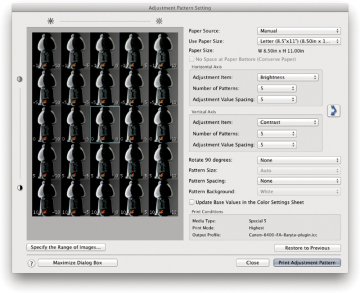
FIGURE four.39. The Color Settings panel and the Adjustment Blueprint Settings dialog box.
THE Adjustment Design SETTINGS DIALOG BOX
If yous click the Print Adjustment Pattern button, you lot run across something similar to the old Photoshop Variations interface. Y'all can select the adjustment item—any of the colors, brightness, saturation—the number of patterns (I could fix information technology to between 3 and 7), then suit the value spacing. You tin run across how much strength is in the modification. You can fifty-fifty control both the horizontal and vertical axes, which is what makes it look like the quondam Photoshop Variations option. I don't utilize this at all for color. I practise employ it for printing to blackness and white, which I cover afterward in the affiliate.
Under the Print History tab, you can command whether information is included on the print, such as the printer name, fourth dimension, or filename. This could be useful if y'all're doing a myriad of examination prints; you could automatically print specific information so y'all could go along the different prints directly.
The last tab is Back up. Click there to go to the Canon back up Spider web folio or user manual.
That is it for the plug-in. So, would I use the Canon printer plug-in on a regular basis? Probably not. There are some shortcomings, such as its disability to salve settings—every fourth dimension you lot impress, you would need to go through and set all the settings correctly. I'yard a large laic in making printing efficient and mistake costless, which segues nicely to the next section!
Automated printing using Deportment
I believe the ability to record printing actions started with Photoshop five, without a dandy deal of fanfare. Dave, the engineer in charge of the Photoshop Impress module, based in Minneapolis, worked very hard to clean out and re-engineer the Impress dialog box. He was the i who fabricated it possible to tape the Print dialog box as an action.
I won't teach an all-encompassing tutorial on creating actions, merely I will show you briefly how to tape an action to make a print, and then I'll prove y'all how to apply that action to do fast press in Bridge.
In the Actions console, click Create New Activity. Name information technology (I'll call it 4900 letter), select a set up to add together it to (I'll create a new set called Printer Actions), and so click Tape.
Now choose File > Print to open up the Print dialog box. All the changes you brand in the Impress dialog box and the print settings will exist recorded equally a component of the action. I start by setting the printer to the Epson Stylus Pro 4900, click Impress Settings, gear up it to Usa Letter of the alphabet Sheet, select Paper Cassette, Exhibition Fiber, SuperPhoto 2880, and set Finest Detail to On. At that place are no more newspaper settings involved, and I won't alter the avant-garde media command. Then I click Save.
Back in the Photoshop Impress Settings dialog box, cull Photoshop Manages Colors. Select the profile; I'k going to select the Epson – 4900 – FA- Baryta, which uses the Exhibition Fiber newspaper settings I selected in the printer settings.
Select Normal Printing, then Relative Colorimetric, with Black Point Compensation turned on. For the purposes of this demonstration, I'll select Calibration to Fit Media. Then I'll click Print. Effigy 4.forty shows the effect of recording the action in Photoshop.
Effigy four.41 shows the expanded brandish of all the parameters recorded in the action. Notice the print options included in the action: color space, RGB color, the profile, the rendering intent, the printer proper name—literally everything that was set in both the Photoshop Print dialog box also every bit the printer commuter. Detect that the Print One Copy is checked in the action steps. If I played that activity, it would send the image to the printer and make a print. If you lot merely want to ready the settings, uncheck that option. The result will be the aforementioned as simply clicking Done in the Photoshop Impress dialog box.

Effigy four.41. The recorded parameters of the activity and unchecking the Print One Re-create footstep.
UNCHECKING THE Impress 1 Re-create Pace
Once y'all've recorded an action, you can close the certificate without saving and take access to all the settings speedily in any document. For example, when I open up a new prototype that hasn't had any printer settings stored in information technology, I can just select the 4900 Letter activeness in the Actions panel and click Play, and all the settings that were recorded in the activity accept been propagated into the Photoshop Print Settings dialog box: the colour handling, printer contour, print settings, size, and position. So once all the settings are propagated, I need merely make whatever changes on a per-image ground so I can print. The action serves as a print preset then that all the settings are handled and you but need to customize it for your specific image. Sadly, the Canon printer plug-in does not capture all the plug-in settings—a weakness of the plug-in.
You tin extend this basic action past incorporating a series of boosted actions before yous play the impress activity. For example, y'all could create actions for sizing, positioning, and output sharpening. Y'all tin can actually create a multiset activity. So, in Bridge, select the images, choose Photoshop > Photoshop Batch, and set upwardly your Photoshop actions in the Batch dialog box.
Just await, in that location's more! With the release of Photoshop CS6.1 (13.1), and continued in Photoshop CC, is the power to record actions using a Provisional Activeness step in your deportment. After creating a new action, go to the Deportment panel flyout carte du jour and select Insert Conditional. Figure 4.42 shows the Conditional Action dialog box and the If Electric current menu showing all the possible potential conditional options.
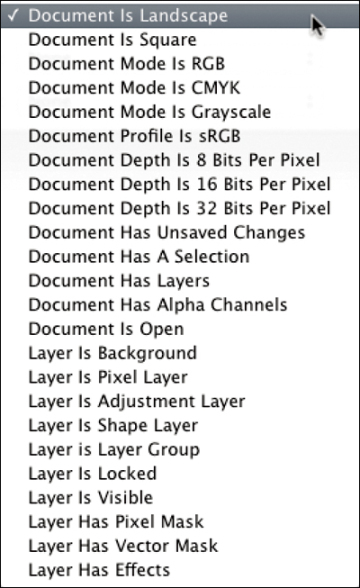
Figure iv.42. The Conditional Activeness dialog box.
THE IF CURRENT DROPDOWN Bill of fare
This is a uncomplicated if/then ready of weather condition. If the condition is met, then you can select a previously recorded action to play. If the condition is not met, then y'all tin choose a different action to play. OK, I'll admit this is sort of geeky, but if you are experienced in recording actions, this new functionality is an important characteristic of Photoshop automation. But if you combine a provisional action pace in a series of recorded steps, then yous can do a Batch command from Photoshop or Bridge. Figure 4.43 shows the recording of a uncomplicated conditional pace to rotate a landscape epitome to portrait orientation prior to printing.
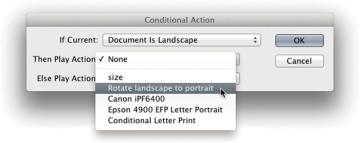
Click to view larger image
SELECTING A PREVIOUSLY RECORDED Activity "ROTATE Landscape TO PORTRAIT" IF THE IMAGE IS IN LANDSCAPE ORIENTATION

FIGURE 4.43. Recording a conditional activeness step.
SELECTING NONE IF THE Status IS NOT MET
When run on an prototype, if the orientation is Landscape (meaning wider than taller), the provisional will run the activity to rotate the paradigm from landscape to portrait orientation. If the image is not landscape, nothing will exist done. If this conditional pace is added to additional action steps, then you tin can use the series of steps to automate the processing of multiple images. Effigy 4.44 shows an activity named Provisional Letter of the alphabet Print that contains the previous instance conditional step plus the running of an image resize step, a Print Options step, and a Print One Copy step followed by a Close footstep (without saving).
The provisional action step will rotate mural images to portrait, simply it won't impact square or portrait images. All images will be sized to an eight-inch tiptop and and so printed. Since the last step is to close without saving, you don't demand to worry about overwriting your original files. Using Bridge you could select a series of images and print them without having to deal with mural or portrait orientations, and then size them and make prints using a Photoshop Batch command.
collieryoureaturs.blogspot.com
Source: https://www.peachpit.com/articles/article.aspx?p=2119011&seqNum=2
ارسال یک نظر for "Is Printing From Photoshop the Best for Fine Art Prints"